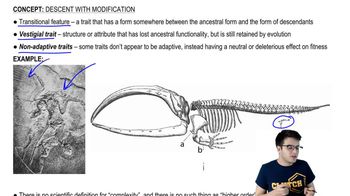Table of contents
- 1. Introduction to Biology2h 42m
- 2. Chemistry3h 40m
- 3. Water1h 26m
- 4. Biomolecules2h 23m
- 5. Cell Components2h 26m
- 6. The Membrane2h 31m
- 7. Energy and Metabolism2h 0m
- 8. Respiration2h 40m
- 9. Photosynthesis2h 49m
- 10. Cell Signaling59m
- 11. Cell Division2h 47m
- 12. Meiosis2h 0m
- 13. Mendelian Genetics4h 44m
- Introduction to Mendel's Experiments7m
- Genotype vs. Phenotype17m
- Punnett Squares13m
- Mendel's Experiments26m
- Mendel's Laws18m
- Monohybrid Crosses19m
- Test Crosses14m
- Dihybrid Crosses20m
- Punnett Square Probability26m
- Incomplete Dominance vs. Codominance20m
- Epistasis7m
- Non-Mendelian Genetics12m
- Pedigrees6m
- Autosomal Inheritance21m
- Sex-Linked Inheritance43m
- X-Inactivation9m
- 14. DNA Synthesis2h 27m
- 15. Gene Expression3h 20m
- 16. Regulation of Expression3h 31m
- Introduction to Regulation of Gene Expression13m
- Prokaryotic Gene Regulation via Operons27m
- The Lac Operon21m
- Glucose's Impact on Lac Operon25m
- The Trp Operon20m
- Review of the Lac Operon & Trp Operon11m
- Introduction to Eukaryotic Gene Regulation9m
- Eukaryotic Chromatin Modifications16m
- Eukaryotic Transcriptional Control22m
- Eukaryotic Post-Transcriptional Regulation28m
- Eukaryotic Post-Translational Regulation13m
- 17. Viruses37m
- 18. Biotechnology2h 58m
- 19. Genomics17m
- 20. Development1h 5m
- 21. Evolution3h 1m
- 22. Evolution of Populations3h 52m
- 23. Speciation1h 37m
- 24. History of Life on Earth2h 6m
- 25. Phylogeny2h 31m
- 26. Prokaryotes4h 59m
- 27. Protists1h 12m
- 28. Plants1h 22m
- 29. Fungi36m
- 30. Overview of Animals34m
- 31. Invertebrates1h 2m
- 32. Vertebrates50m
- 33. Plant Anatomy1h 3m
- 34. Vascular Plant Transport1h 2m
- 35. Soil37m
- 36. Plant Reproduction47m
- 37. Plant Sensation and Response1h 9m
- 38. Animal Form and Function1h 19m
- 39. Digestive System1h 10m
- 40. Circulatory System1h 57m
- 41. Immune System1h 12m
- 42. Osmoregulation and Excretion50m
- 43. Endocrine System1h 4m
- 44. Animal Reproduction1h 2m
- 45. Nervous System1h 55m
- 46. Sensory Systems46m
- 47. Muscle Systems23m
- 48. Ecology3h 11m
- Introduction to Ecology20m
- Biogeography14m
- Earth's Climate Patterns50m
- Introduction to Terrestrial Biomes10m
- Terrestrial Biomes: Near Equator13m
- Terrestrial Biomes: Temperate Regions10m
- Terrestrial Biomes: Northern Regions15m
- Introduction to Aquatic Biomes27m
- Freshwater Aquatic Biomes14m
- Marine Aquatic Biomes13m
- 49. Animal Behavior28m
- 50. Population Ecology3h 41m
- Introduction to Population Ecology28m
- Population Sampling Methods23m
- Life History12m
- Population Demography17m
- Factors Limiting Population Growth14m
- Introduction to Population Growth Models22m
- Linear Population Growth6m
- Exponential Population Growth29m
- Logistic Population Growth32m
- r/K Selection10m
- The Human Population22m
- 51. Community Ecology2h 46m
- Introduction to Community Ecology2m
- Introduction to Community Interactions9m
- Community Interactions: Competition (-/-)38m
- Community Interactions: Exploitation (+/-)23m
- Community Interactions: Mutualism (+/+) & Commensalism (+/0)9m
- Community Structure35m
- Community Dynamics26m
- Geographic Impact on Communities21m
- 52. Ecosystems2h 36m
- 53. Conservation Biology24m
21. Evolution
Introduction to Evolution and Natural Selection
Problem 4`
Textbook Question
How can evolutionary fitness be measured? Select True or False for each statement.
T/F Document how long individuals survive.
T/F Count the number of healthy, fertile offspring produced.
T/F Determine which individuals are strongest.
T/F Determine which phenotype is the most common.
 Verified step by step guidance
Verified step by step guidance1
Understand the concept of evolutionary fitness: It refers to an organism's ability to survive and reproduce in its environment. Fitness is often measured by the number of offspring an individual produces that survive to reproduce themselves.
Evaluate the statement 'Document how long individuals survive': Survival alone does not directly measure evolutionary fitness unless it contributes to reproduction. Consider whether longevity leads to more offspring.
Evaluate the statement 'Count the number of healthy, fertile offspring produced': This directly measures evolutionary fitness, as it reflects the individual's contribution to the next generation.
Evaluate the statement 'Determine which individuals are strongest': Physical strength may contribute to survival and reproduction, but it is not a direct measure of evolutionary fitness unless it results in more offspring.
Evaluate the statement 'Determine which phenotype is the most common': Common phenotypes may indicate successful traits, but evolutionary fitness is specifically measured by reproductive success, not just prevalence.
 Verified video answer for a similar problem:
Verified video answer for a similar problem:This video solution was recommended by our tutors as helpful for the problem above
Video duration:
2mPlay a video:
Was this helpful?
Key Concepts
Here are the essential concepts you must grasp in order to answer the question correctly.
Evolutionary Fitness
Evolutionary fitness refers to an organism's ability to survive and reproduce in its environment. It is often measured by the number of offspring an individual produces that survive to reproductive age. This concept emphasizes that fitness is not solely about strength or survival duration but rather about reproductive success and the passing of genes to the next generation.
Recommended video:

History of Evolutionary Theory Example 1
Survival Duration
While survival duration can indicate an individual's fitness, it is not a direct measure of evolutionary fitness. An organism may live a long time but produce few or no offspring, thus contributing little to the gene pool. Therefore, survival alone does not equate to evolutionary success; reproductive output is a more critical factor.
Recommended video:
Guided course

Introduction to Bacterial Plasmids
Phenotype Frequency
Phenotype frequency refers to how common a particular trait or characteristic is within a population. While understanding which phenotypes are most common can provide insights into natural selection, it does not directly measure individual fitness. Fitness is more accurately assessed through reproductive success rather than the prevalence of traits in a population.
Recommended video:

Allele Frequencies

 4:58m
4:58mWatch next
Master Evolution and Natural Selection with a bite sized video explanation from Jason
Start learningRelated Videos
Related Practice
































